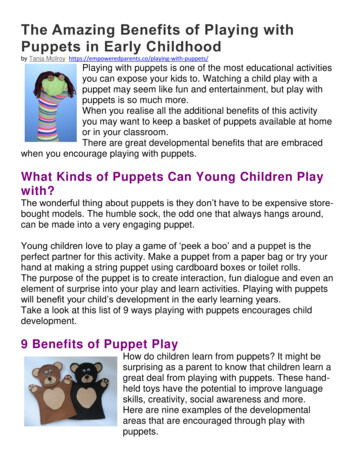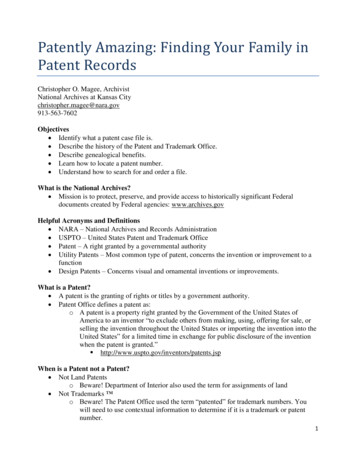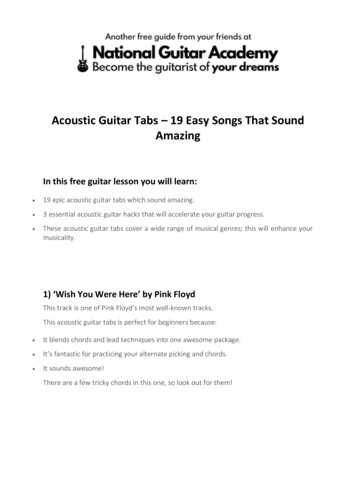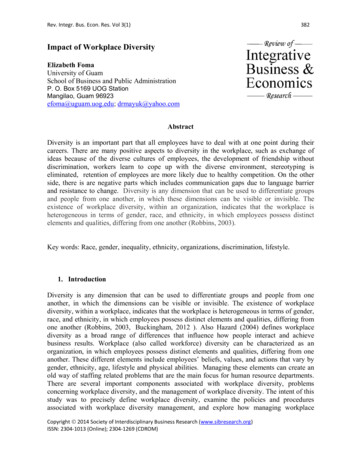
Transcription
The Amazing Benefits of Playing withPuppets in Early Childhoodby Tanja Mcilroy laying with puppets is one of the most educational activitiesyou can expose your kids to. Watching a child play with apuppet may seem like fun and entertainment, but play withpuppets is so much more.When you realise all the additional benefits of this activityyou may want to keep a basket of puppets available at homeor in your classroom.There are great developmental benefits that are embracedwhen you encourage playing with puppets.What Kinds of Puppets Can Young Children Playwith?The wonderful thing about puppets is they don’t have to be expensive storebought models. The humble sock, the odd one that always hangs around,can be made into a very engaging puppet.Young children love to play a game of ‘peek a boo’ and a puppet is theperfect partner for this activity. Make a puppet from a paper bag or try yourhand at making a string puppet using cardboard boxes or toilet rolls.The purpose of the puppet is to create interaction, fun dialogue and even anelement of surprise into your play and learn activities. Playing with puppetswill benefit your child’s development in the early learning years.Take a look at this list of 9 ways playing with puppets encourages childdevelopment.9 Benefits of Puppet PlayHow do children learn from puppets? It might besurprising as a parent to know that children learn agreat deal from playing with puppets. These handheld toys have the potential to improve languageskills, creativity, social awareness and more.Here are nine examples of the developmentalareas that are encouraged through play withpuppets.
Language DevelopmentChildren love to have ‘conversations’ with a puppet. Each verbal interactionwith their puppet will encourage language development.Children who are generally shy really benefit from the opportunity to let thepuppet be their voice. It is also possible to have a conversation between twopuppets. Wearing a puppet on each hand enables the puppeteer to have adialogue going on between two puppet characters.Social DevelopmentThe shy child, or the young child still learning social skills, has anopportunity to be more sociable through the medium of a puppet. Thepuppet becomes the spokesperson for the group.A puppet can be the voice used to correct table manners or other socialskills. The puppet becomes the instructor and children often enjoy listeningto the puppet teaching them to be sociable. It is not mom or dad’s voicesetting the rules again, but a funny puppet character.Emotional DevelopmentPuppets can teach children about their emotions.Children can interact with the puppets as they share their ability to behappy, sad, angry, funny or jealous.Children can express these emotions too without upsetting anyone. Theirpuppet character is the one to feel these emotions. Playing with theemotions of the puppets helps to develop the characteristics of sympathyand empathy too.Children also experience this kind of expression when engaging in symbolicplay.Listening Skills.Puppets are great tutors.The puppet on your hand can encourage your child to listen to it as it givesinstructions or tells a story.Puppets can help children to learn rhymes and songs as they imitate thepuppet too.Motor SkillsThere are a number of motor skills that children can improve throughplaying with puppets.The fine movement required to wear a puppet helps with dexterity and usingfingers to manipulate the puppet improves fine motor coordination.Marionettes or string puppets help with eye-hand coordination as the puppetis made to walk and move in different directions.
All these skills improve balance and directionality as the child has great funplaying with the puppet.Building Self ConfidencePutting on a puppet show often happens quitespontaneously when children have access topuppets.It is really encouraging to see how childrendevelop their self-confidence through the act ofhandling a puppet. As their confidence growsthey will be happy to entertain family orfriends.The puppet is centre stage and the childbecomes more confident to speak in front of other people with the help of apuppet friend.CreativityPuppets encourage creativity on several differentlevels.Making your own puppets from recycled socks or paperbags is just the starting point. There are manyinteresting ways to create your own puppet characters.Creativity continues by creating a puppet show. Theshow will need a simple puppet theatre and decoratingan old cardboard box for this purpose adds to thecreativity factor.Story Telling and SequencingStorytelling comes alive with puppets. Retelling favourite fairy tales is agreat way to put on a puppet show.Learning how to repeat the rhyming part of the story, like in the GingerbreadMan, helps with memory skills.Puppets lend themselves to being the characters in your stories and allowyour child to join in with the action.Travel CompanionsPacking a puppet in your travel bag or even popping one in your handbag isa wonderful way to provide entertainment when you need it. A hand or glovepuppet and a storybook are all you need for some holiday travel fun.
Next time you are caught in the doctor’s waiting room, a puppet and a bookmay be all you need to distract your child. The beauty ofpuppets is they are lightweight, unbreakable littleentertainers and they travel well.The creator of the Muppets, Jim Henderson, had this tosay about the value of puppets:“One of the nicest things about puppets is that it’s yourown hand in there. You can make it do anything youwant to.”As a parent, you can add all the benefits of handling apuppet to that statement. Instead of just watching apuppet show you can bring the real thing into your home.It is really beneficial to encourage your child to play with puppets knowingthey are going to learn at the same time.How to Make Simple PuppetsIt is not difficult to make your own puppets.Children are generally happy withsomething you have made together andcreated for the purpose of telling stories orputting on a puppet show.Sock puppets are the easiest little crittersto make. A couple of googly eyes and a bitof red felt for a tongue and hey presto youhave a snake.Make sure the sock is a nice long one togo right up your arm. Your silly snake or worm can play ‘peek a boo’ or singsilly songs.Keep a stack of paper bags for rainy days and make paper bag puppetswith stickers and marker pens to decorate.You will be amazed at how easy it is to make a funny face on a paper bagand then use the flap or fold at the front of the packet for a mouthpiece.Let your paper bag puppet talk and sing funny songs. Paper bag puppetswill encourage all the benefits of puppets including creativity and craft.Here are step-by-step instructions to make 4 simple types of puppets.I hope you’ve enjoyed reading about learning through puppets!
4 Types of Puppets That are Easy to Makewith Your Kidsby Tanja McilroyChildren love to play with puppets and there are many educational reasonsto play with them.Making your own can add creativity to the list of benefits of puppet play.Your creation does not have to be a state of the art puppet! A bit of time anda few basic materials found in your home are all you need.You and your child will have fun creating and playing with your homemadepuppet characters.Why Preschoolers Should Play with PuppetsHaving fun and entertainment with a puppet is top of the list of reasons whyplaying with puppets is beneficial for preschoolers. In addition, you can besure puppets will improve language skills, boost confidence and help yourchild with many other educational milestones.Different Types of Puppets to Make The following puppets are the easiest to make at home.sock puppetspaper bag puppetsglove puppetssimple string puppetsThe beauty of these types of puppets is that the resources you need areright there in your home. Start with the easiest – the humble sock puppet –and move on down the line of DIY puppet creations.Sock PuppetsSock puppets are such fun to make because they arequick and easy.Choose a long stocking type of sock so the puppet willcover your arm and look more authentic. Sock puppetsare ideal for the peek-a-boo villain. Peek-a-boo puppetscan pop up all over the place for a tickle and the surpriseelement of the game.
What you will need:An old sockGoogly eyes or black felt to cut out eyesRed felt for a tongue if you make a snakeNeedle and cottonScissorsGlueInstructions:Choose a long sock that will cover the arm of the puppeteer.Cut out eyes and a tongue for a snake. If that is a bit frightening, make aworm instead.Glue or stitch the eyes and the tongue in place.Googly eyes could be used instead of felt depending on the age of the childinvolved. You’ll want to avoid little pieces that could be pulled off andaccidentally eaten if your child is still at that stage of development.Practise putting your hand inside the sock and pinching the end betweenyour thumb and fingers. This is where you would want a mouth to be.Wiggle your hand and sing a silly song – perfect entertainment with yourvery first homemade puppet.Paper Bag PuppetsBrown paper bags make wonderful puppets.These paper bags can be saved from a shopping spree orcan be bought at a store. Look for a bag that will fit overyour hand.The best type of packet has a bottom part to stand onwhen it is opened up. This flap at the bottom becomes themouth of the puppet.Paper bag puppets are light and easy to wear. Theydecorate easily, and although they are not long-lasting,they are simple and not expensive to make. What you will need:A brown or white paper bag with a flat bottomGlueScissorsStickersMarking pens
Other creative waste items like cotton wool for beards or ribbon or woolHave a box or basket with all sorts of bits and pieces available to put ontothe DIY paper bag puppet. (This is a great way to encourage your child touse their imagination. A creative wastebasket is always handy for othercreative activities.)Instructions:Start by imagining the character you will make. If it is arabbit, for example, you will need bunny ears, eyes,nose, whiskers and a mouth.Cut out all the bits and pieces required to make yourpuppet.Use coloured paper, stickers and coloured pencils tocreate the features of the puppetCreate arms and fit them into the fold on the side ofthe paper bag to look as if they are sticking out fromthe side of the puppet. Or just draw them on the front of the packet.Don’t forget to decorate the back of the puppet too. Bunnies need a fluffytail, for example.Practise slipping your hand into the packet and fitting your fingers into theflap to move it up and down like a mouth.Now your puppet can talk and be part of the conversation.Glove PuppetsThe glove puppet is a step up from the sock andpaper bag puppet. Two versions of the same conceptare possible. An old knitted glove or a fabric versionof a glove puppet.The head of a glove puppet is operated with themiddle three fingers of the hand while the two armsare moved by the thumb and baby finger.If you decide to use an old glove then cut off thethumb and little finger of the glove for your ownthumb and finger to appear. This is optional but itdoes make it easier for your preschooler to wear theglove. The other three fingers will hold up theheadpiece.You can create tiny finger puppets out of the pieces you cut off.
The head of this puppet may be a circle of felt decorated to make the face ofthe puppet.Alternatively, make a glove puppet by sewing fabric or felt together in theshape of a puppet head and two hands at either side. Decide on yourcharacter beforehand to use scraps and other creative bits and pieces for itsfeatures. What you will need:Old glove or a glove puppet shape sewntogether to fit your child’s handYour creative wastebasket with scraps ofwool, felt, buttons, pompoms, googly eyesand cotton wool. All these items are veryuseful for creating the features on thepuppet.ScissorsGlue or needle and cottonInstructions:Decide on the basic body and arms for the glove puppet.Cut out the mitt and sew round to make the arms and head shape or cut offthe finger and thumb of a glove. Stitch a thread through the tips of themiddle fingers of the old glove version to keep them together.Now that you have the basic shape of your glove puppet you can cut out ahead with ears from felt to attach to either the knitted glove or to the cutand-sew mitten.Use your creative waste materials to make eyes, ears, nose and a mouth.Make hair out of wool or cotton wool.Glue or stitch on the hair, eyes, ears, nose andmouth.Have fun creating the character you havechosen. A pirate, for example, will needearrings and an eye patch. Perhaps a scar onhis face will give him a real pirate look.Look at pictures in books for ideas. Create thebest version of your very own glove puppet.
String Puppets String puppets, or marionettes, are the most complicated of this range ofDIY puppets. However, a simple step by step instruction sheet and a coupleof toilet rolls will make the task easier for you.Managing a string puppet encourages eye-hand movements and control ofa foreign object. Your child may need some extra help with this puppet, butonce the instructions have been followed it is easy to repeat them and makeother puppet characters.You could make a dog and take it for a walk in the park!What you will need:Two toilet roll inners. Cut one in half for the head and leave the other for thebody.One piece of dowel rod about 30cms long. An old ruler can also do the trickor use an old wooden coat-hanger.Plain paper to cover the toilet rolls, orpaint.ScissorsString and four big buttons or beadsGlueStickers or marking pensYour creative waste box of wool, googlyeyes, felt scraps, cotton wool and pipecleaners.Instructions:Cut one toilet roll in half for the head section. Then, cover both piecesseparately with paper or paint them the colour for the puppet character youhave chosen to make.Decorate the body and head to suit the puppet you are making.Use your scissors to make four holes in the body roll for the legs on theunderside of the roll.Remember, using pointed scissors is a job for an adult – help will be neededhere.Make two holes in the top and bottom of the head section to join with astring for the neck. This will link with the rod to make the puppet’s headmove.Make two holes on the upper side of the body roll for the neck string and thetail end string linked to the control stick.
Now create the puppet’s finer features. Use your creative wastebasket forthis activity.Cut four strings for the legs and attach a bead or big button on the end ofeach string for the feet of the puppet.Now you are ready to assemble your puppet. Push the four strings for thelegs through the holes in the toilet roll and pull them through to make a knoton the end that will secure the legs in the toilet roll.The bead or big button on the end will give the string a bit of weight as thepuppet ‘walks’ along.The hole in the end of the body has a string knotted at the end and pulledup to join onto the rod at the top.The head is joined with a string that acts as a neckpiece and goes throughthe roll to join onto the rod at the top.Now you have your simple toilet roll string puppet ready to rock and roll andtake a stroll down the passage. Watch how much concentration and eyehand coordination it takes to get the puppet moving and see how much funthis play and learn activity brings to your home.Make a box version of this simple string puppet with a cardboard carton oran old yoghurt container. This simple version needs three strings – one forthe top of the head and one each for the feet. It’s ideal for a penguin or arobot character and even more simple to operate.Now the show can begin!Tell your child about the puppet Pinocchio. In the Disney version of thislovely fairytale, there are some delightful songs to sing along to. Make up aPinocchio show and enjoy handling a string puppet. Who knows – maybeyour puppet can come to life too!A Creative Wastebasket Keeping a creative wastebasket in your line up of resources is a really goodidea. This basket of tricks can serve you on a rainy day or when friendscome to visit. Find an old box or basket and set to work filling it with all sortsof bits and pieces that are readily available to make and create.Here’s a list of suggestions:scrap paper and coloured cardcrayons and marker pensblunt-nosed scissors
HB pencils and an eraserbrown paper packetsold magazinesbuttons and bows – bits and bobs from your sewing stashelasticstickers and stampsfelt and scraps of fabricgoogly eyespompomswool and cotton wool.These are just a few ideas for your creative wastebasket. When you startcollecting you will find many more interesting things to keep for new projectsand ideas.I hope you’ve enjoyed learning about making puppets!
A puppet can be the voice used to correct table manners or other social skills. The puppet becomes the instructor and children often enjoy listening to the puppet teaching them to be sociable. It is not mom or dad’s voice setting the rules again, but a funny puppet character. Emotional Dev










